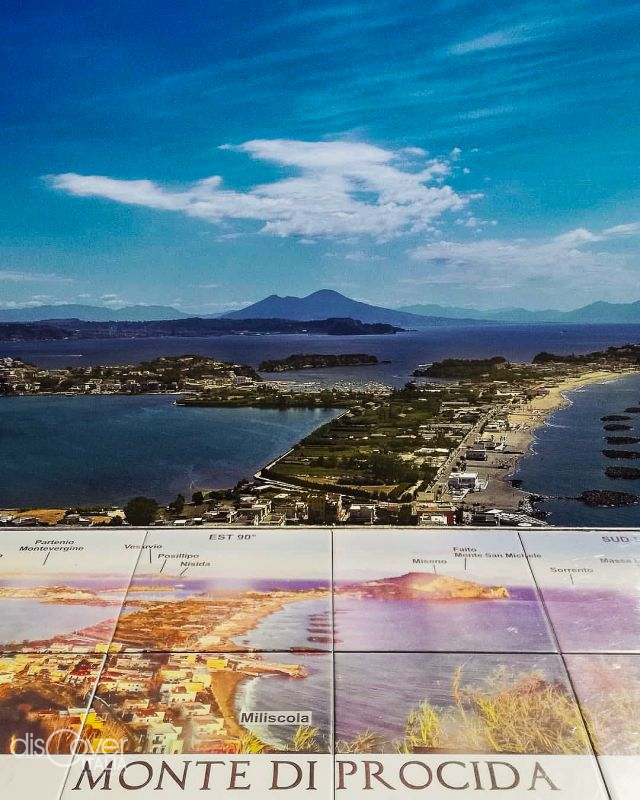A promontory that has the geological history of the "burning earth" written in its stratified rocks. Guarding that part of sea that leads to the Gulf of Naples and separates the Phlegraean Peninsula from the island of Procida from which it takes its name.

And to which that stretch of continental coast has linked its destiny for centuries. So much so that it retains traces of it in its official name, Monte di Procida, even after the administrative autonomy obtained with a referendum back in 1907. That hill overlooking the sea, with a very wide view from the Sorrento Peninsula to the Circeo and the Pontine islands and equipped with various landing possibilities, had all the useful and necessary features to be inhabited since the most ancient times. And it was in fact chosen already in the Neolithic, to then welcome one of the settlements of Cuma, a rising power that, thanks to that very village, in a strategic position on the sea, was able to strengthen its control over the routes to the central northern Tyrrhenian. Thus, as long as the Greek city was in charge, the promontory was identified as Mount Cumano mentioned by Dionigi of Alicarnasso in the 6th century BC. Then, when in Roman times Miseno, with its very important port, became a “municipium”, the name also changed to Monte Miseno. Then, for the first time, the most panoramic points of the "terrace of the Phlegraean Fields" were appreciated, where the rich Romans built splendid otium villas. In the imperial age, the significant presence of Jews among the sailors of the fleet stationed in Miseno favored an early spread of Christianity in the Phlegraean area. It’s certain that the apostles Peter and Paul landed on those shores and visited the Christian communities of Torregaveta and Miseno, to which the deacon Sossio later belonged, martyred at Solfatara with the bishop Gennaro in 305.
When the Roman Empire dissolved, to defend the population and the territory from the continuous attacks of the barbarians, the mountain was transformed into a castrum with the construction of a belt of fortifications that extended all the way to the sea. At the time of the Neapolitan Duchy, the continuing state of war, together with the Saracen raids, impoverished the population and caused a progressive depopulation. The destruction of Miseno in 850 pushed most of those who remained to move to the neighboring island of Procida. The mount was also administratively aggregated to the island, and only few farmers remained, nature returned to rule there with an increasingly dense vegetation. Therefore, in the 15th century, King Ferdinand I made the Monte a royal hunting reserve.
It was in the 17th century that a reverse flow began, from Procida al Monte, where gradually the land owned by the archdiocese of Naples, terraced and plowed, was once again destined for agriculture. Mainly wheat and vines were grown there and Montese wine became very popular. Once Navigation and trade resumed, a demographic increase finally occurred and also continued in the following century. The village developed between the hills and the coast, where was erected a church that would later become the mother church of the Mount, dedicated to the Assumption of the Virgin. In front of that sacred building, in 1799 an elm became the Tree of Liberty, a symbol of membership of the Neapolitan Republic. And in that same place, after the return of the Bourbons, Stefano Coppola, the martyr for freedom of Montese origin, was executed.
It was at the beginning of the 20th century that the inhabitants of the Mount began to claim autonomy from Procida, to which they were still subjected. After various vicissitudes, they reached their goal with the referendum of January 27, 1907. The request by the inhabitants to name the new municipality New Cuma, however, was not accepted and the name linked with Procida prevailed. Then, in the second half of the century, a new, massive emigration to the United States began and had the cities of the Atlantic coast as its preferred destinations.
Most of the emigrants and their descendants are still closely linked to their town of origin and to the cult of the Assumption, so much so as to ensure a wide participation in the annual celebrations of August 15 around the oldest church, dedicated to Maria Santissima Assunta that, built in the 17th century, was enlarged and renovated several times, along with the increase of the population. Thus, in 1742 a second nave was added to the original structure; in 1776 the new altar was placed. the organ and various stuccos and ornaments inserted; in 1853, elevated to parish, the third nave, the chapel, the sacristy and the rectory were added. Finally, in 1882, the bell tower with a clock was built. Of particular value is the image of the Madonna, found on the beach, which is believed to be miraculous is also very affective for the faithful.
Among the monuments of Monte di Procida is the ancient farmhouse converted into a villa in the early 1900s by the lawyer Agostino Matarese, with interiors embellished with splendid Art Nouveau decorations and, all around, a large flowering park. But the main attractions are the belvederes, allowing visitors to admire between land and sea the unique views of the Gulf of Naples and the islands. Among the most celebrated places is the Stupor Mundi viewpoint, along the road between the historic center and Miliscola beach, that frames the panorama of the Capo and Lake Miseno with the Phlegrean coast as far as Vesuvius. The walk along Acquamorta’s little dock is also highly suggestive. The impression of walking on the sea is made even more special by the proximity of the island of Procida, behind which Mount Epomeo and the hills of the island of Ischia rise, while on the right the islet of San Martino can be admired.
Ph: Martina Iacuaniello



Comments powered by CComment